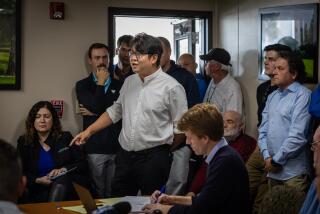Denying Responsibility Seems to Be Par for the Course
- Share via
To Susan and Bob Wilmot, the answer to who’s responsible for denting Susan’s 1991 Honda with an errant tee shot is crystal clear.
To golf course manager Joe Cannon, the answer is also crystal clear.
It’s just that they have totally different answers. And somewhere in the middle of it all is a silver-haired man owning a shirt with a diagonal stripe who needs golf lessons.
Add to the list of Life’s Vexing Questions the following: If you’re driving down a major public street and your car is plunked by a golf ball from the adjacent golf course, who should pay for any damages? Is it:
A) The golfer who hit the shot?
B) The golf course management?
C) The driver of the car?
Susan Wilmot, eight months pregnant at the time, was driving on Edinger Avenue in Fountain Valley last September when a golf ball from the David Baker Golf Center struck the hood of her car, denting it. Startled and upset, she pulled over and telephoned her husband. But because she had seen a foursome looking out into the street, she saw who hit the shot and pulled into the golf course parking lot.
She said the employees in the pro shop told her the course management wouldn’t reimburse her, but someone from the pro shop volunteered to drive her in a cart onto the course to confront the foursome. She spied a silver-haired man as the culprit but, according to Wilmot, “he said he didn’t know anything about it.”
She let them go but, alternately crying and calm, approached them again a few minutes later. Eventually, she said, the silver-haired man said he’d admit striking the blow but only if the golf course management or his insurance would cover the damages. That conversation ended, however, as his playing partner prodded him to continue their game, she said.
Afterward, golf course officials reiterated to the Wilmots that any damage was the golfer’s responsibility. Wilmot reasoned it was the golf course’s responsibility because it hadn’t erected a substantial enough protective fence or some other obstruction between the course and Edinger.
Huntington Beach residents when the incident occurred, the Wilmots have since moved to Nevada, but in a phone conversation Tuesday Wilmot dismissed suggestions that his wife--or anyone in a similar situation--has a responsibility to track down the golfer: “What if you have a major traffic accident (from a ball hitting a car) and you can’t get to the course? There’s got to be some ultimate responsibility taken somewhere.”
The only logical place, he contends, is with the course management. He reasoned that the course is a business that charges people to play there and that it has responsibility for damages that result from the business.
The Wilmots filed a claim with American Golf Corp., which operates the course, but it was rejected. They also filed a claim with Orange County government, which leases the land to the golf company, but the county also ash-canned it.
The repair job cost $491.19, which the Wilmots paid. “I really don’t have the time and energy to go to Small Claims Court over $500,” Bob Wilmot said. Because the amount was less than their deductible, the Wilmots couldn’t file an insurance claim.
*
Meanwhile, over at the golf course, manager Joe Cannon said it’s unreasonable to hold course operators responsible for bad golfers. Just as a golfer is responsible for hitting someone on the course with an errant shot, so should the golfer be accountable for hitting someone off the course, he said.
That would mean ‘fessing up when someone confronted them with a bill for car repair. Given that golfers are all too willing to claim a 6 when they shot a 7, I wonder about the likelihood of owning up to financial liability.
Anyway, I asked Cannon how reasonable it is to expect a pedestrian or driver to come to the course and find someone on the fairway whose ball struck them, as Susan Wilmot did. “It’s very realistic to find the golfer if a person comes in immediately,” Cannon said. “It’s unfortunate that he generally doesn’t want to admit it, that he hit a shot that bad. It’s extremely difficult (to get them to confess) unless the guy is above board.”
Even so, Cannon said, it’s not fair to stick the liability with the golf course management.
A hundred people a day play the course, he said, creating 100 potential hazardous drives onto the street. “We have no knowledge how good or bad he is when he comes to pay the greens fee. There’s no requirement that he must be able to play, and even if he’s a good player, this occurs. So as a consequence, I don’t see how anyone could say that the course should be responsible.”
Why not build a large fence, as some courses have, when a fairway runs near a street? Cannon said he once worked at a course that put up a 40-foot-high fence and “it doesn’t do a bit of good in the world. If someone has hit a ball that poorly, it goes over the fence anyway.”
The good news is that things like this apparently don’t happen often. In his 3 1/2 years at Baker, Cannon said maybe 15 people have come to complain about golf ball damage.
To his knowledge, he said, no golfer on the course has ever confessed to hitting the stray shot.
More to Read
Go beyond the scoreboard
Get the latest on L.A.'s teams in the daily Sports Report newsletter.
You may occasionally receive promotional content from the Los Angeles Times.










